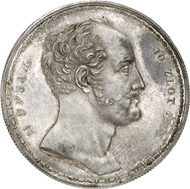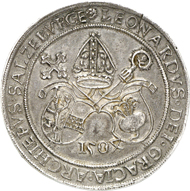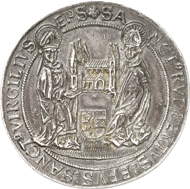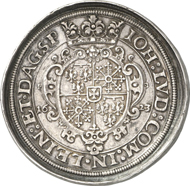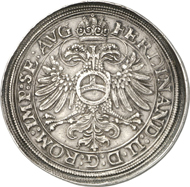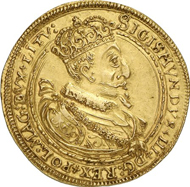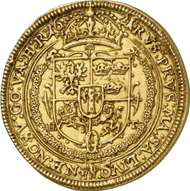01-02-2012 – 01-01-1970
Auctions 201-203
New German record price with auction house Künker at World Money Fair
Auction house Künker has set a new record on the German market with 650,000 Euros. It happened on February 2, 2012, at the World Money Fair in Berlin, where a Chinese Dollar from 1911 had set the previous year a hitherto all-time high with its price of 460,000 Euros.
1621: RUSSIA. Nicholas I (1825-1855). 1 1/2 Rouble (10 Zlotych, “Family Rouble”) 1835. Bitkin 885 (R3). Dav. 286. Only 36 spec. mint., showpiece of Pol. dies, splendid patina, about brill. uncirc. Estimate: 150,000 Euros, hammer price 650,000 Euros.
The Dollar was by far surpassed by a so-called Family Rouble by Russian Tsar Nicholas I from 1835. “So-called” because it is not a coin worth one Rouble but a commemorative coin of 1 1/2 Roubles (10 Zlotych for Poland, respectively). There are five variants from the time span 1825 to 1855, and Künker, for the first time ever, was able to present all five of them at the same time! In catalog 203 “High-quality Russian Coins” it went blow on blow starting with catalog number 1621: 650,000 Euros, 240,000 Euros, 90,000 Euros, 55,000 Euros, 380,000 Euros. All five examples were sold to anonymous winners bidding on the telephone. The attendants in the crowded hall were left in the position of an amazed, applauding audience.
The commemorative coins are a family history of a special kind that has its origin in Germany: inspiring example had been the Geschichtstaler of Bavarian King Louis I from 1828. According to the Bavarian model, the obverse shows the portrait of the ruler, the reverse the portraits of his family. Nicholas’ wife Alexandra Fedorovna is surrounded by her children Alexander, Maria, Olga, Constantine, Nicholas, Mikhail and Alexandra. The Tsarina had been a native of Prussia, bearing the name Frederica Louise Charlotte Wilhelmine. Her eldest son later became Tsar himself, Alexander II. The depiction of Nicholas is unique for a coin image: as a rule, he was never shown in person but always as crowned “N I.”.
All five Family Roubles easily outdid their estimates in the Estrel Convention Center in the Berlin Sonnenallee. The pre-sale price tags read 150,000, 100,000, 40,000, 20,000 and 250,000 Euros. The Family Roubles came with an expert report of the State Historical Museum Moscow. At the beginning of the auction the director of the Moscow Coin Cabinet, Dr Igor Shiryakov, and the head of the auction house, Fritz Rudolf Künker, stressed the huge importance of the items on offer for the European history of money.
The five Family Roubles made significant contributions on the total estimate of the roughly 200 numbers of the Russian catalog being exceeded by 90 per cent and, consequently, the hammer prices coming close to three million Euros. Only four lots went into the re-sale. The splendid results of the Family Rouble mustn’t cloud the fact that there were other extraordinary individual results. Three cases in point: the ten-times Rouble (1 Imperial) 1896, estimated at 100,000 Euros, yielded 140,000 Euros, the 37 1/2 Rouble 1902 yielded 77,500 Euros, a platinum coin of 12 Roubles 1830 brought 70,000 Euros.
Hence, Russia was more than successful, but by no means put the other two catalogs of the one-day auction in the shade. Auction house Künker had an exquisite Salzburg Collection to offer with the Collection Friedrich Popken. The lists of Archbishops ranged from Pilgrim II von Puchheim (1365-1396) to Ferdinand (1803-1806). 21 short biographies, plus illustrations and historical backgrounds – with this auction Künker proved once again that an auction catalog can be much more than a mere sales catalog with bare figures. A well-founded work of reference, not only to Salzburg collectors. One or two objects were not within easy reach for them because the hammer prices rose quickly in this section as well.
1004: SALZBURG. Leonhard von Keutschach (1495-1519). Guldiner (“Rübentaler”) 1504. Dav. 8154. Original struck, only ten spec. mint., attr. spec., patina, tiny planchet error, ef. Estimate: 100,000 Euros, hammer price 110,000 Euros.
The “Rübentaler”, a Guldiner 1504 of Prince-Archbishop Leonhard von Keutschach improved by ten per cent to 110,000 Euros. And hence affirmed its appreciation as one of the most sought-after coins of early Modern Times. With the same estimate, i.e. 100,000 Euros, Andreas Jakob von Dietrichstein started with his gold medal of 100 Ducats from 1747. The “only known example in princely possession” (catalog text) is not only a splendid specimen but brought a superb hammer price with 210,000 Euros. At the lower end of the price scale respectable results were to be witnessed, too: a Batzen 1511 of already mentioned Leonhard, for example, improved by more than 100 per cent and yielded 60 Euros on its estimate of 25. The Salzburg result: 196 numbers, 196 hammer prices, total proceeds 1.6 million Euros, i.e. 55 per cent more than the total estimate.
Everything other than Russia or Salzburg was assembled together in catalog 201 under the title “Numismatic Rarities”. Of the roughly 800 lots only eight went into re-sale. The total estimate of 4.3 million Euros faced hammer prices adding up to almost six million Euros, an increase of about 34 per cent.
619: LEININGEN-DAGSBURG. Johann Ludwig (1593-1625). Thick double Reichstaler 1623. Dav. 6877. Unique specimen, ef. Estimate: 100,000 Euros, hammer price: 110,000 Euros.
Three results of more than 100,000 Euros came from this catalog: 110,000 Euros (estimate 100,000 Euros) were achieved by the thick double Reichstaler 1623 of the County Leiningen-Dagsburg. The silver coin, weighing 63 grams, of Count Johann Ludwig is an extremely fine unique specimen. The same hammer price was yielded by a gorgeous, oval-shaped golden gem of Swedish King Gustav II Adolph from 1631.
51: POLAND. Sigismund III (1587-1632). 1/2 Portugalöser of 5 Ducats 1621. Fb. 78. Of utmost rarity, ef. Estimate: 75,000 Euros, hammer price: 120,000 Euros.
Even better was a 1/2 Portugalöser (five Ducats) of Polish King Sigismund III from 1621: estimate 80,000 Euros, hammer price 120,000 Euros. Hence, numismatic rarities, which, like their results, can be viewed on the internet.
At Künker’s you can as well download a brochure on the Family Roubles in occasion of the auction. Simply click here.
A comprehensive article on the phenomenon of the Russian Family Roubles you can find in our archive.



